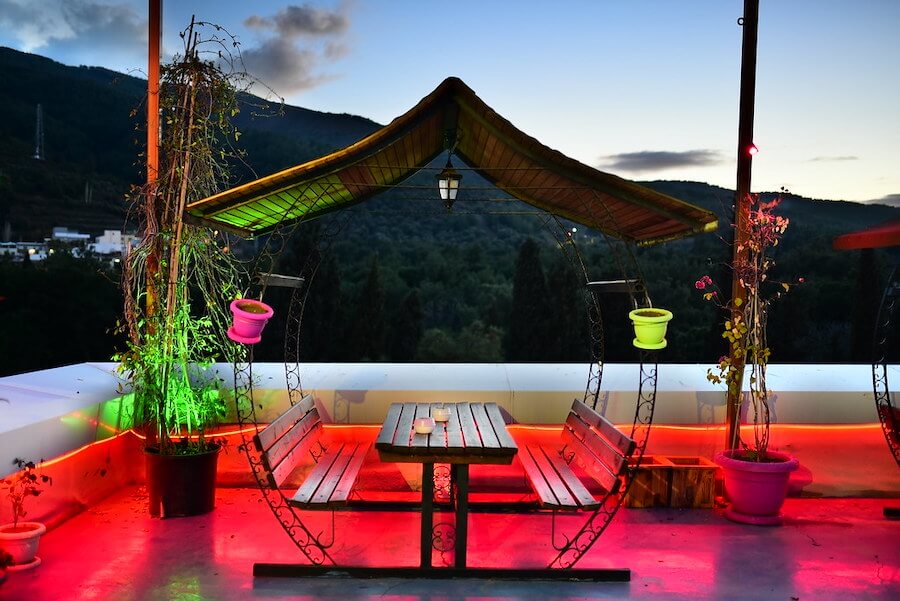A pergola is perfect for relaxing and having fun with your family and friends. Consider adding a roof to ensure the weather won’t interrupt your relaxation.
But what is the best type of roof for a pergola? Today, we will introduce some potential ideas and share tips for settling on the most suitable option.
Let’s join us right now!
Table of Contents
What Is The Best Type Of Roof For A Pergola?
Louvered roofs are the best options for their advanced features. However, some people may prefer retractable ones because they are highly convenient.
You can’t find a one-size-fits-all answer to this question because you may look for particular qualities when choosing a pergola roof.
There are seven types of roofs you can add to a pergola. They serve specific purposes, so you must consider your requirements to choose the best one.
We will discuss each type of roof. Please check them carefully and you won’t regret your decision.
Louvered Roofs
A louvered is a cutting-edge and contemporary solution to offer shade to your outdoor spaces. It has different names, such as an adjustable patio cover, motorized pergola, or opening roof.
This roof can protect you from the weather and give your outdoor living space a special visual identity, adding a high value to your pergola.
The design features angled blinds to control light and ventilation. It can also keep out rain and harsh sunlight.
Some designs have a remote-control feature, allowing the light to enter and preventing the rain from attacking whenever you want.
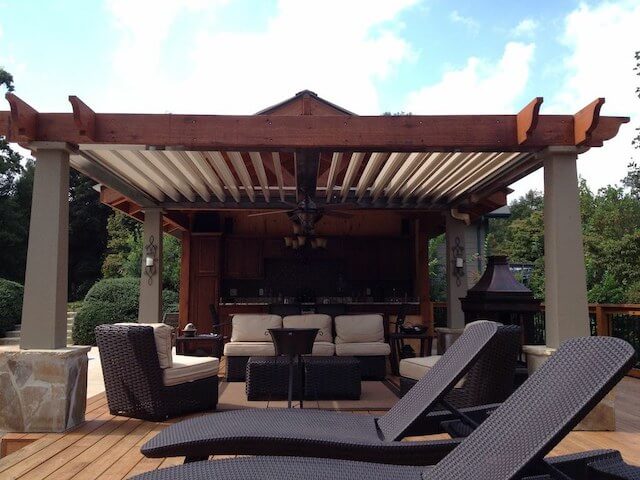
Retractable Roofs
Retractable pergolas consist of a series of connected slats that you can extend and retract to limit the amount of light invading.
By modifying the length of the retractable roof, you may alter the weather conditions in your outdoor area.
For example, when it’s raining, you can fully extend the roof to form a shelter. And when it’s hot, consider opening the slats so light can come in while you can block the heat.
These models are more expensive than most pergola roofing options. Yet, they give you the highest level of flexibility.
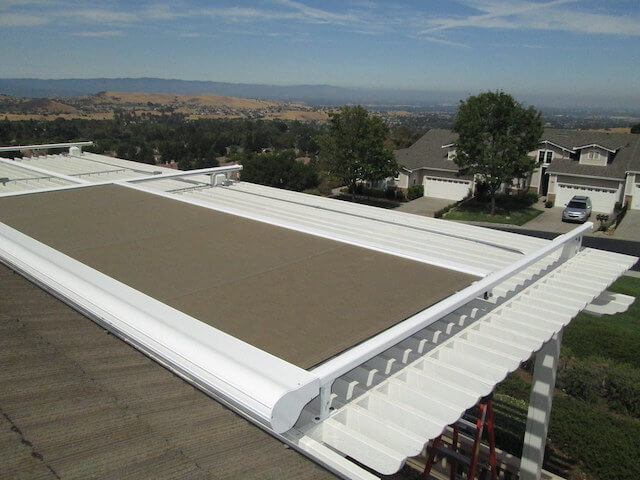
Polycarbonate Roofs
Polycarbonate pergola roofs are an excellent option for a robust and long-lasting structure.
These roofs are a fantastic choice for those who prefer some privacy because you can find frosted or tinted panels to add shading.
Moreover, polycarbonate is thermoplastic, making it popular in reusable bottles and bulletproof windows.
Last but not least, modern translucent polycarbonate materials let natural light pass through while blocking the sun’s harmful UV radiation.
Static Paneling
Static paneling is a contemporary method of creating outdoor roofs. You will also love its fashionable designs.
Static paneling is a roof that has solid panels. You can move or open the panels easily. If you want a straightforward method, you will want to take advantage of it.
The roof also offers privacy for your outdoor space because it gives shade. Some are transparent, but they all can block the sun’s heat and allow natural light.
You can find panels made of multiple materials. PVC, aluminum, and wood are the most popular choices.
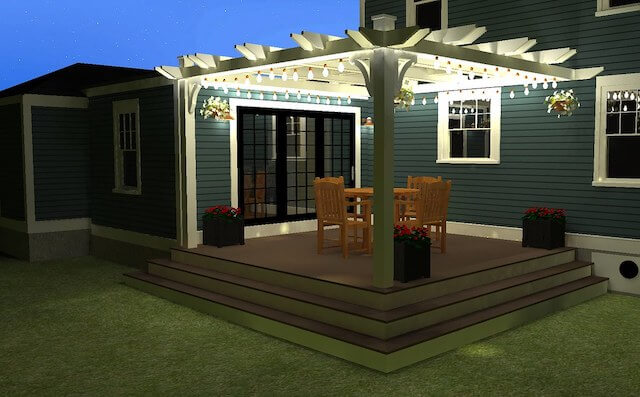
Fabric Paneling
A fabric roof contains fabric panels that can be easily closed and opened. It’s a good choice if you want to control the amount of light attacking your pergola.
You can choose the ideal shade for your outdoor living area thanks to the wide range of colors available in fabric paneling. Some common choices are acrylic, polyester, and canvas.
The best fabrics of the line are Ferrari 601 and 502 vinyl. They are both waterproof and give you a private space.
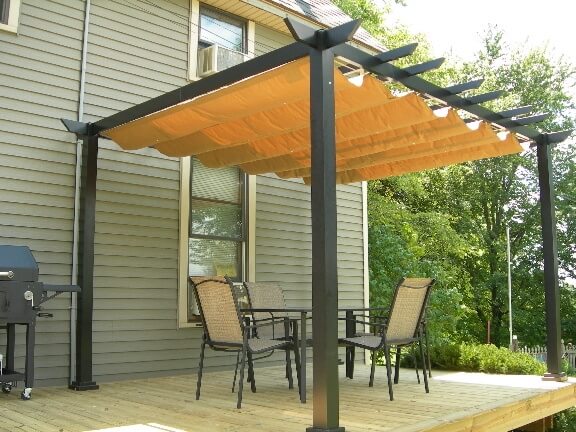
Flat Colorbond Roofs
Colorbond might be the most fabulous patio roof material for your flat roof. You can use it to create an outdoor dining space that is as cozy as an interior one.
Besides, this material is lightweight, making it easy for your pergola roof to cover a large area with little vertical support.
Although this roof stays flat, you can slightly rake it for the water to run off. The ceiling will help you install recessed lights to construct a poolside patio. Your pergola will turn out to be much more enjoyable.
Finally, Colorband is available in many colors. So be creative and find the best style for your entertaining space.
Thatched Roofs
These green roofs were prevalent in older times, but they are not suitable as a pergola with a modern style.
Nevertheless, thatch might become the ideal roofing material for your patio if you like its natural and rustic appearance.
Thatch is a cool fiber in the summer and a natural insulation method for noise and heat. Thanks to the thatch’s expansion and stiffening, it will protect you from the rain.
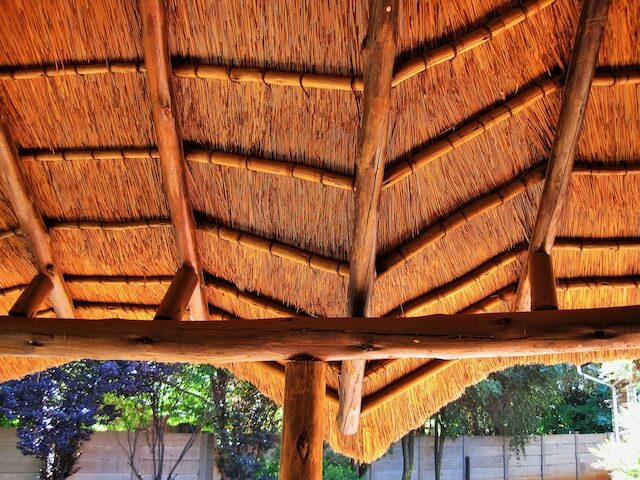
How To Choose The Best Type Of Roof For A Pergola?
Climate, style, and cost are the three most important considerations you need to take. Your options will be as follows:
Climate
The environment is one of the most crucial factors to take into account while selecting roofing for your pergola.
You should pick a roof that can reflect heat if you live in a region with a lot of sunshine. On the other hand, go for a roof that will shield you from external elements if your area has a lot of rain.
Many different roofing materials are widely accessible, so do your research to choose the most suitable one.
Style
Styling is an important part of setting a pergola. But you will end up ruining the overall look of your setup with an out-of-place roof.
We advise sketching your outdoor structure carefully, from the bottom to the roof. They should complement each other, establishing a harmonious impression.
Cost
Building a pergola will be a big investment. To optimize your budget, try to plan everything in detail. Some affordable materials may help you cut down the cost.
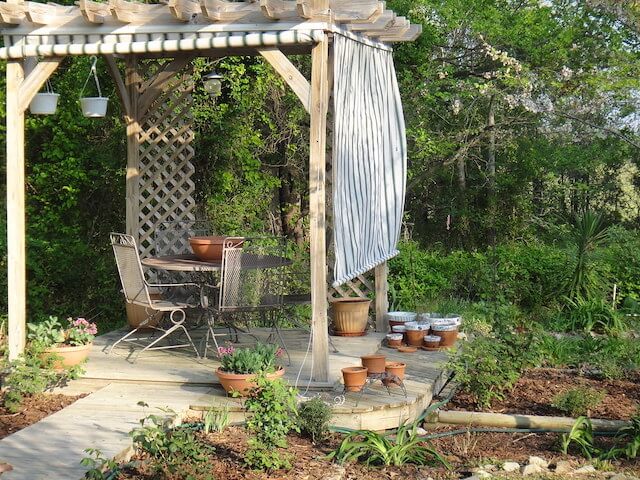
Should You Put A Roof On A Pergola?
Some people choose to skip the roof. They have their own reasons. So let’s learn the pros and cons of installing a roof on your pergola to predict what may happen to you.
Pros
- Privacy: If you construct your pergola in your garden, the roof you can enjoy your time there, and your neighbors won’t disturb you.
- Protection: A roofed pergola can keep your outdoor space cool. This quality is highly beneficial if your area has a lot of sun exposure.
- Aesthetics: If you are looking for an idea to improve the appeal of your pergola, consider adding a roof to it. There are many materials and styles to achieve a perfect look.
Cons
- Cost: Adding new features means adding the cost. So if you want to save money, find the type and material of the pergola roof that is the most cost-effective.
- Difficulty: If you have never tried installing the roof, consider hiring a professional to do it for you.
How To Maintain Pergola Roofs?
Maintaining your pergola roof once you’ve had it built is crucial. Make sure to check the roof for any wear and tear routinely.
Also, trim the trees nearby to prevent damage caused by falling branches. This maintenance tip is crucial for those living in areas with many trees.
Cleaning is an essential part of maintenance. The following tips will help you do it properly.
- Clean off the roof of any dust, debris, and mildew that has gathered there. This task often calls for a soft brush and garden hose.
- After removing the dirt, clean the pergola roof with water and bleach in a 3:1 ratio.
- Check the roof for any sign of damage or loosening. If you detect any, fix or replace them as soon as possible.
- Always scrub the roof gently, especially when you have a fabric one. After scrubbing, clean it with water.
- Do not use harsh solutions or brushes because they will damage the material or color of the roof.
- Apply a protective coating so you can clean the roof easier. Follow the product’s instructions carefully and allow the roof to dry completely after the treatment.
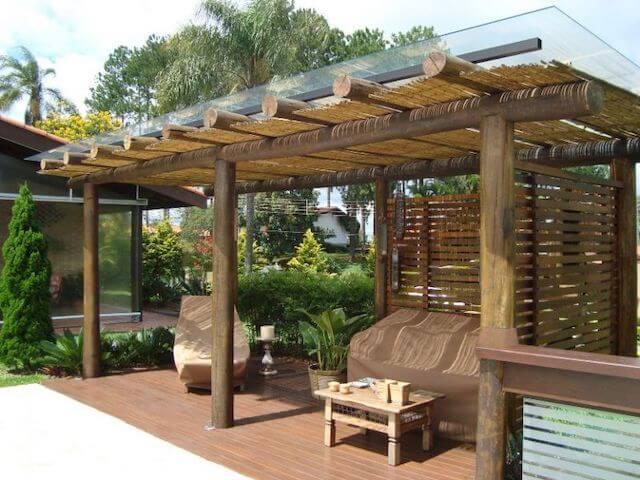
FAQs
1. How tall should a pergola roof be?
8 to 12 feet is the standard height for a pergola. But you don’t always have to follow it. For instance, if you need an eight-foot head clearance, the beams can raise it to at least nine feet, and the rafters will add ten more feet.
2. What can you put on top of a pergola to keep the rain out?
You can either buy a metal roof or construct your own waterproof cover using plastic or corrugated metal. Plus, the raindrops may make a lovely sound as they hit the metal pergola cover.
3. Can a pergola have a solid roof?
Yes. Compared to canopies, solid proof can help protect you from external elements. It can also maintain your original pergola’s open-air effect and gorgeous look.
4. What is used to cover the roof of a pergola?
A tarp is a fantastic way to cover the roof of your pergola temporarily and permanently. Here is a detailed process:
- Measure your pergola roof. It must be large enough to cover the top.
- Stretch the tarp over your pergola to each corner.
- Attach fabric or rubber tie-downs to the tarp’s corners. There must be holes on the tarp for you to hook.
- Tighten the other tie-down end to a horizontal or vertical pergola beam.
5. What kind of wood should I use for a pergola roof?
Cedar and pine are the best choices of wood you can use for your pergola roof. They are sturdy, long-lasting, good-looking, and easily accessible.
6. What can you put on top of a pergola to keep the rain out?
The best solution in this situation is a louvered roof since it has a waterproof construction and allows precipitation to flow off.
This inventive cover also works whether you need to close or open your roof to block out the sun and heat.
Conclusion
There are many types of roofs for a pergola. Before choosing the best one, you should consider various factors, such as climate, cost, and style.
Hopefully, this guide can help you determine the roof that your pergola goes best with. Thank you for reading!

